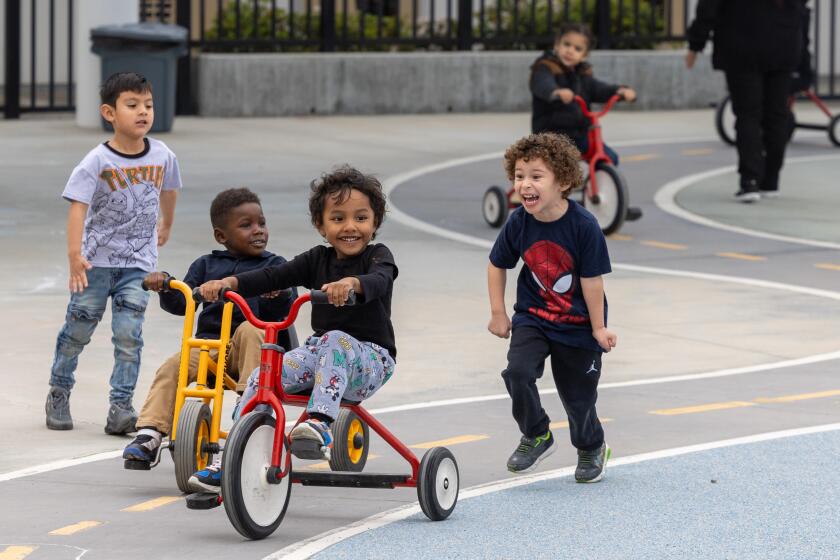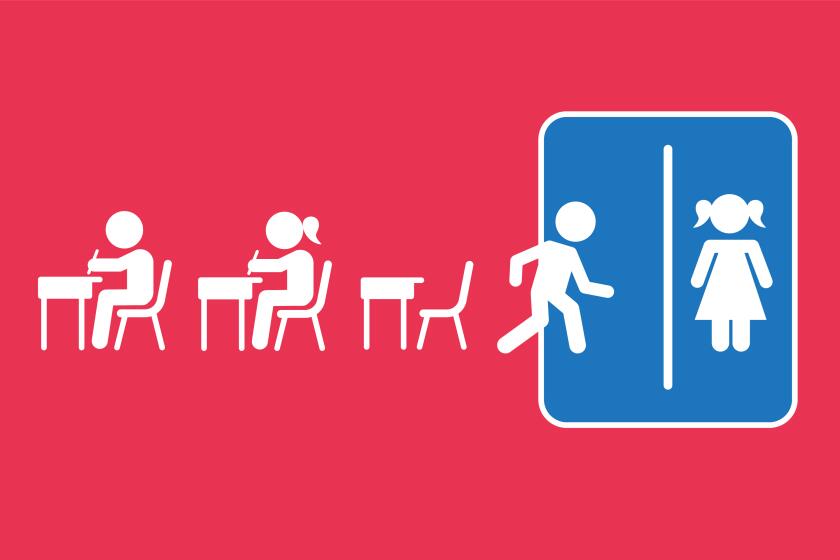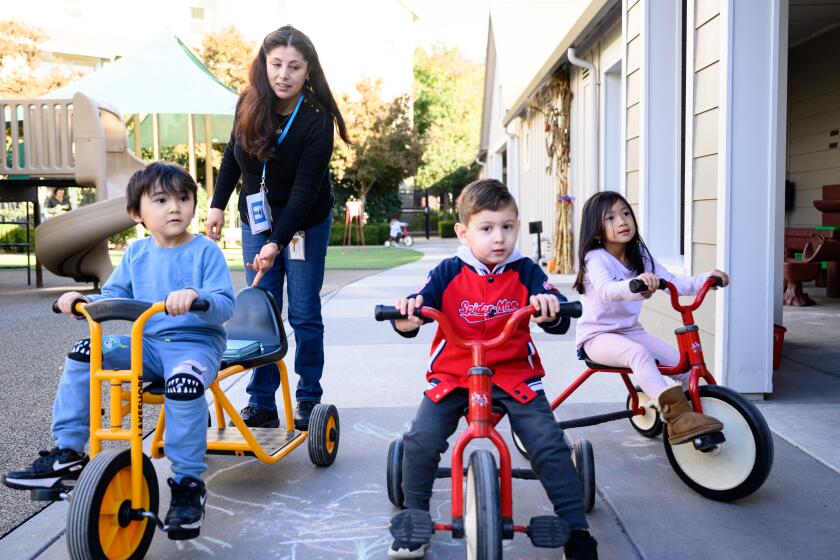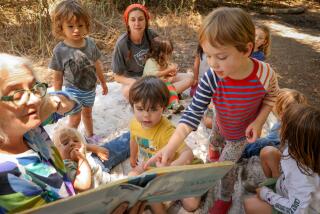
Yelena Hagooli has done everything possible to give her 4-year-old son the best start in life. She took him to the library every week, fed him the healthiest foods, left her job to care for him, and even moved to Beverly Hills because she’d heard such good things about the schools.
But the parenting decision she is grappling with now feels more momentous: Should she keep him in his beloved preschool for another year or send him to the newly expanded transitional kindergarten, called TK for short, at her local public school?
She’s looked at the question from every angle, and even paid a $1,000 nonrefundable deposit to secure his spot at his temple-based preschool to give herself more time. Moving him to TK would save $20,000 a year in tuition, and both her sons could attend the same school. But it’s been difficult to find out details of the new TK program. And her youngest is content where he is, immersed in their community and Jewish traditions.
Reading by 9’s guide to reading readiness. Find expert tips, book recommendations and resources for parents of kids under age 5.
“One moment we think he’s going to be fine in TK, the next we’re like, ‘Aww, he’s just a baby and isn’t ready’,” said Hagooli. “Parents have so much pressure on them now because we know these early years are so important. So what do we do now to set them up so they do well in school, so they get into the right college, etc, etc?”
As California’s major expansion of public education — the addition of TK, a new grade level for 4-year-olds — wraps up its second year, tens of thousands of parents statewide are struggling with their own versions of Hagooli’s question. Their individual decisions may determine the success of the program.
Parents can choose from an assortment of early childhood programs, ranging from child care to preschool to transitional kindergarten. Here’s what they offer.
California is in the midst of a $2.7-billion initiative to provide an additional year of free, high-quality education during the crucial early years. Yet while TK is a statewide program, the details that often matter most to parents — the balance of play and academics and how the program differs from preschool — vary greatly by district. The last major assessment of TK curriculum was done in 2016, long before the current expansion, and the state is not currently evaluating TK classrooms to see how districts are educating their youngest students.
“We’ve told parents that this is one of the most important times of their kid’s life, but we’ve left this information vacuum,” said Anna Markowitz, a professor at the UCLA School of Education and Information Studies. “These are very important questions, and we don’t really have a plan to answer them.”
Here is what we know so far:
What is transitional kindergarten?
TK has been around since 2012, but it was previously only for children with fall birthdays, and it was not available in all districts. But by the 2025-2026 school year, TK will provide a free public education open to all 4-year-olds in what is expected to become the largest universal preschool program in the country.
So far, despite overall growth in the program, many parents appear to be sticking with what they know. The Legislative Analyst’s Office estimates that average daily attendance in TK this year is roughly 125,000. This is a significant increase over last year, but still far from the 400,000 Gov. Gavin Newsom said he hopes will enroll by 2025, when the program is in full swing.
California’s 4-year-olds are entering transitional kindergarten. But many young learners aren’t fully potty-trained, an issue public schools are grappling with.
The state and districts like LAUSD have been working to get the word out about TK. A recent Stanford University RAPID survey found that 83% of parents with children ages 5 and under in California say they are aware of the TK program. And three-quarters of public school parents support state-funded preschool for 4-year-olds, according to a recently-released survey from the Public Policy Institute of California.
What is the difference between TK and preschool?
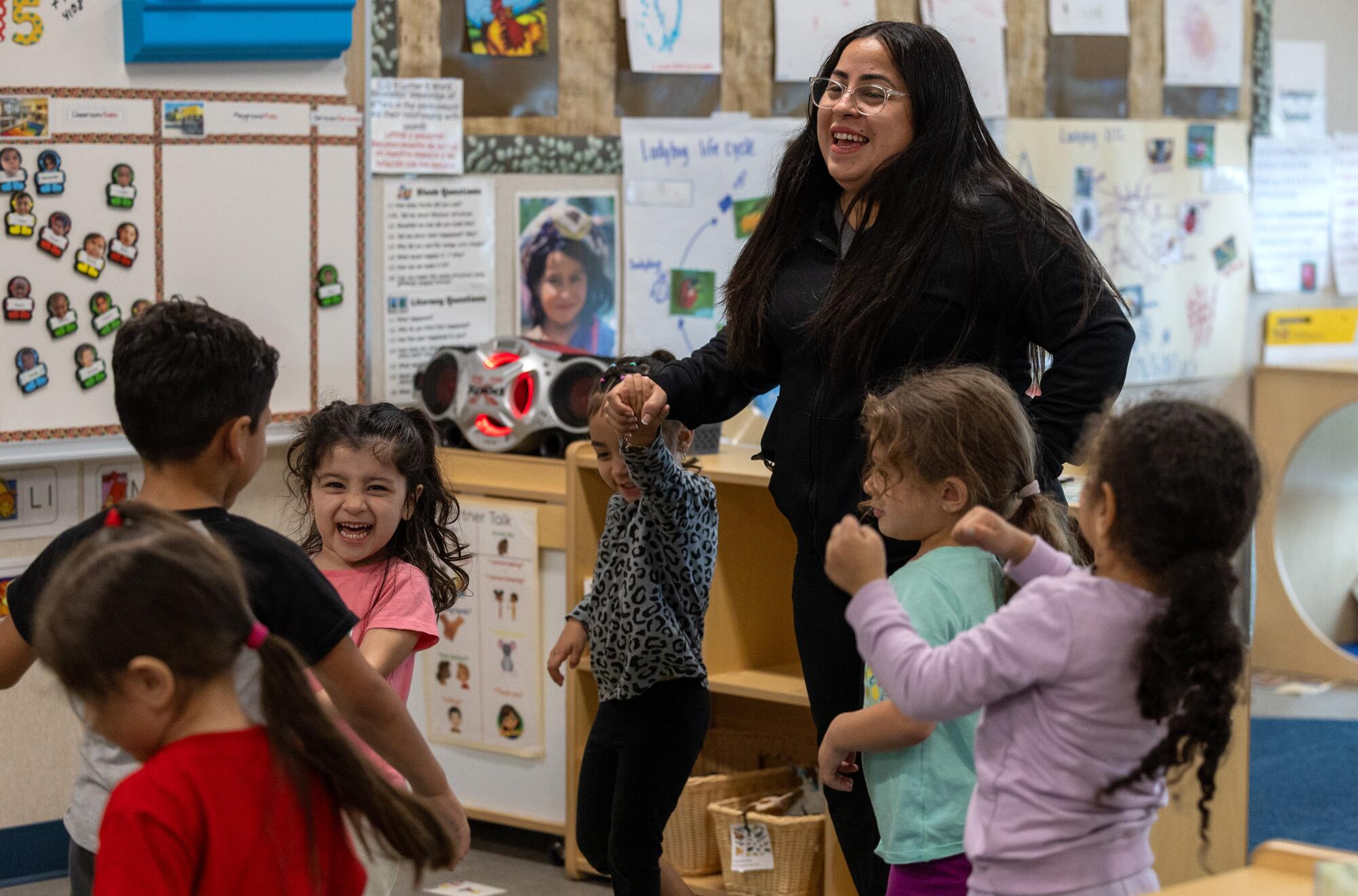
Parents have a wide range of options to choose from when it comes to preschool, from faith-based programs at temples and churches to Montessori and nature schools. Some are focused on free play, while others spend more time on teaching children to learn letters and numbers. Generally when selecting a preschool classroom, parents are able to visit, ask about what is being taught and select the program that best suits their values and needs.
Likewise, TK tends to vary widely by district and individual classroom. But there are several consistencies across the state.
In general, a TK classroom has more students than the average preschool class. A maximum of 24 students can attend a class that must be supervised by two adults, one of whom must be a fully certified TK teacher — a 12-to-1 student-to-adult ratio.
California State Preschool classrooms have a ratio of 8 to 1.
For Hagooli, this may be a deciding factor. Her son is quiet and observant, and she worries that in a larger classroom, the teacher might not pay enough attention to his needs.
But teachers in a TK classroom generally have more education than preschool teachers, including a bachelor’s degree and a teaching credential. By 2025, TK teachers will also need to have 24 units of early childhood education or development.
“TK teachers are probably providing more structured planned learning activities on average because they’re trained to teach,” said Deborah Stipek, an education professor at Stanford University. TK teachers are paid about twice as much as preschool teachers. “Some people are concerned that TK is overly structured for young children,” she added.
Parents can choose from an assortment of early childhood programs, ranging from child care to preschool to transitional kindergarten. Here’s what they offer.
Who is eligible for TK in California?
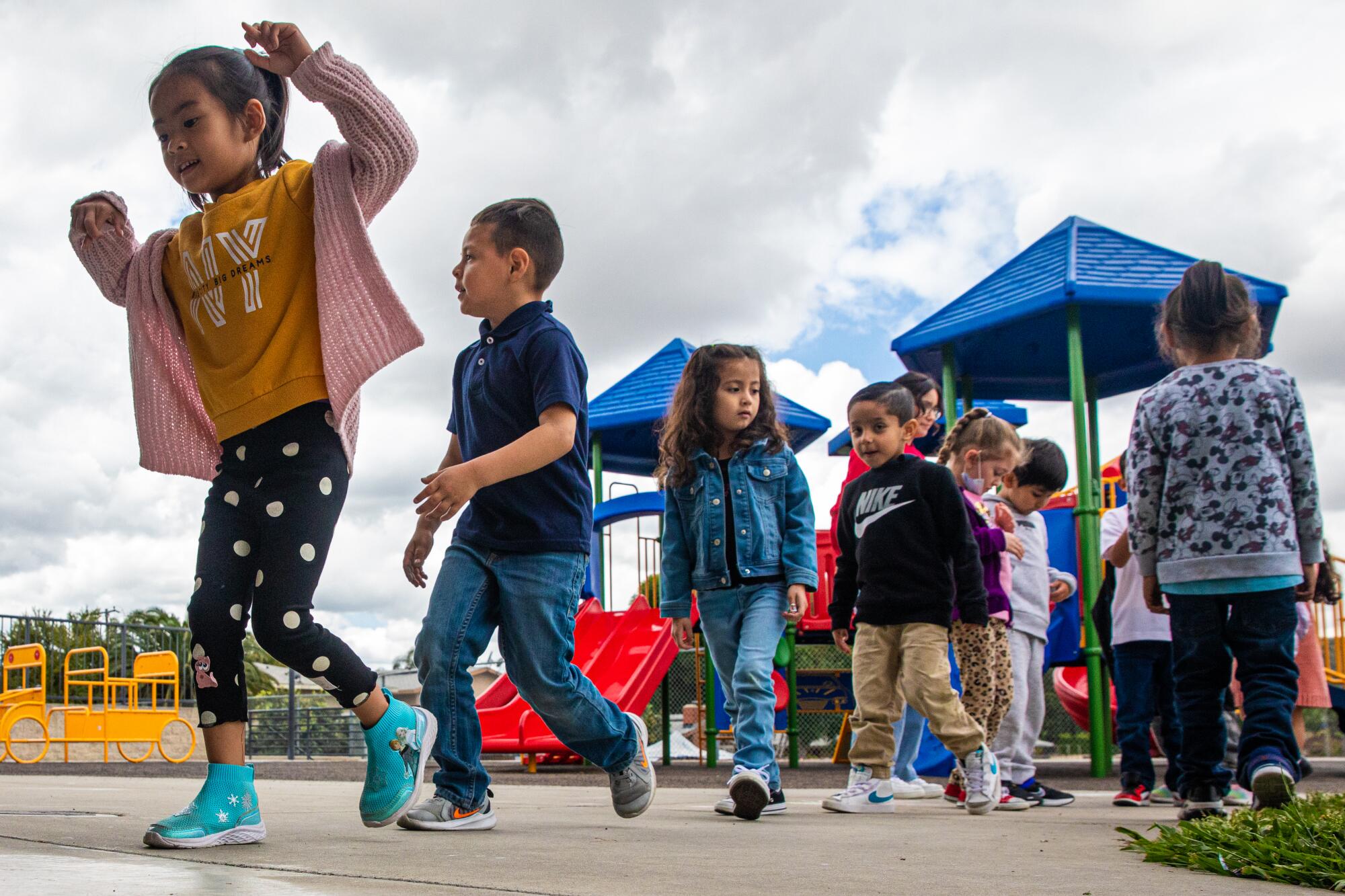
All California children turning 4 by June 2 will be eligible to enroll in TK in the fall. Some districts, including LAUSD and San Diego Unified, are already admitting all children who turn 4 by Sept. 1. The grade is not mandatory.
Districts are required to offer at least three hours of instruction. For parents who require additional child care, schools generally offer after-school programs, though they often charge a fee.
TK classrooms often expect a higher degree of independence from students, which may be challenging for younger children. TK does not offer a nap, for example, and most provide minimal assistance with toileting. In contrast, most preschools still provide naps, diapering and other toileting assistance to the same age group.
For Micaela Elias, that was reason enough to keep her daughter at the Children’s Institute in Vernon, a Head Start program. Her child is still napping, and she worried that in TK, no one would help her open her snacks or nurture her the way her preschool teachers do. “She’s still so little,” said Elias. Since Head Start and state preschool are also free, cost is not an issue for many low-income families.
For Malinda Cvitkovic in Ventura, the higher expectations of independence felt like a plus. In TK, her son learned how to form a line, write his name in pencil instead of crayon, and feel safe in a school environment — all while playing and having fun. In preschool, she said, he was much more “coddled.” She works in his kindergarten class every week now and says she notices “a huge difference between a kid who did TK and a kid who didn’t do TK.”
What do TK students learn in California?
TK students are taught according to the California Preschool Learning Foundations, which were created by the Department of Education and are intended for all preschool programs throughout the state. A new version is likely to be released this summer, which will advance the foundations through TK and age 5½.
The foundations include hundreds of pages of detailed expectations for what children should be learning by age across social-emotional development, language and literacy, math, art, science and even health. By the age of 5, for example, children should know how to:
- Regulate their feelings and impulses more consistently
- Participate positively and effectively in a group
- Write their own name nearly correctly
- Know more than half of uppercase letters and lowercase letters
- Understand and use increasingly complicated sentences
- Understand and use age-appropriate grammar
- Create drawings and paintings that depict people, animals and objects
- Compare two objects by length, weight and capacity
- Solve simple addition and subtraction problems
- Recognize and duplicate simple patterns.
Is TK more academic than preschool?
In an online FAQ, the state department of education calls TK “the first year of a two-year kindergarten program that uses a modified kindergarten curriculum.”
That description was an “unfortunate decision,” said Alix Gallagher, director of strategic partnerships for Policy Analysis for California Education, based at Stanford University. Many school districts took that to mean that TK should look like kindergarten — a grade they were already familiar with — instead of the “developmentally appropriate, play-based curriculum” that the department calls TK in a separate FAQ for parents.
But since each district can choose their own curriculum, the reality varies widely. In some classrooms, children are sitting at desks and doing letter worksheets. In others, they are exploring outdoors, building Legos and playing make-believe.
“I think that’s very hard for parents right now,” said Markowitz at UCLA. “I think the best bet is for them to decide whether they think their kid is ready to be in a kindergarten light.”
California law restricts preschools from expelling kids, yet an increase in behavioral problems since the pandemic is proving a big challenge for teachers.
In 2016, the last time a major evaluation of the state’s TK program was performed, researchers found that students who went to TK entered kindergarten with stronger math and literacy skills. But they also found that teachers spent 59% of their classroom time on “didactic instruction,” which means imparting information and instructions to students rather than encouraging independent thinking and play.
“That would be my least favorite pedagogy,” said Linda Espinosa, a professor of education at the University of Missouri and co-chair of the committee who wrote a recent report on preschool curriculum for the National Academies of Sciences, Engineering and Medicine.
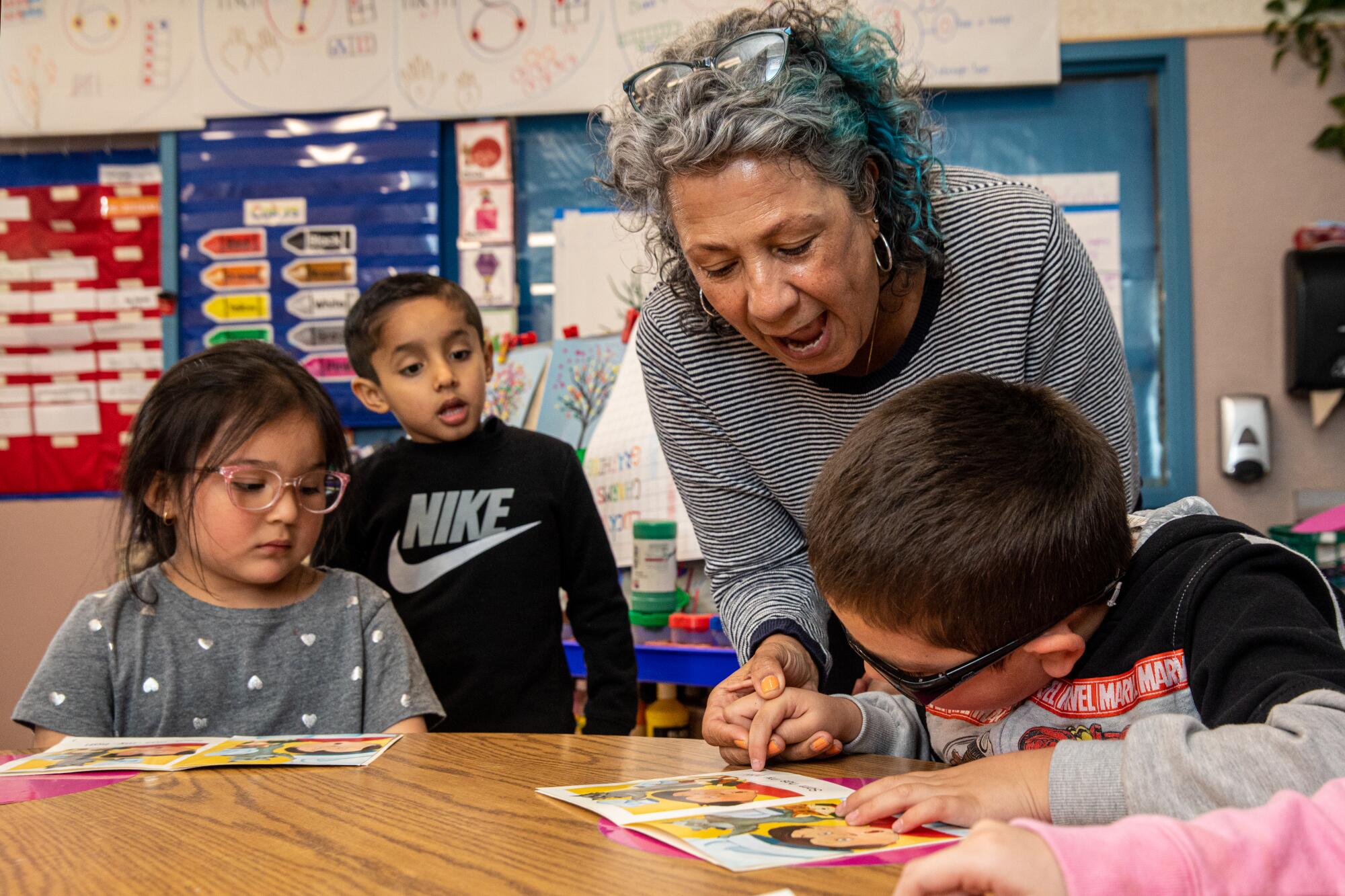
Children should be taught math and literacy, she said, but academics and play shouldn’t be “an either-or.” Instead of being taught their letters and numbers from a teacher standing at the front of the class, children in a well-run classroom should be playing games and exploring materials to learn in joyful and imaginative ways. “If the environment is set up correctly, play-based learning can be very academic,” said Espinosa.
This is happening in some TK classrooms, especially in districts that have long-standing preschool programs where TK is more likely to be play-based, said Hanna Melnick, who co-leads the nonprofit Learning Policy Institute’s Early Childhood Learning team.
Last year, more than half of TK classrooms said they use a literacy and social-emotional learning curriculum developed for preschoolers. But about a quarter were using a kindergarten curriculum.
“Those are the ones that may be most concerning,” said Melnick, adding that some of them might be combined TK-Kindergarten classrooms. “My guess is that people are becoming more educated [about early learning] over time. But I think we’re definitely still going to have some growing pains, especially in smaller, under-resourced districts.”
For some parents, the focus on learning is welcome. Charlotte Angeles, a dental hygienist in Westchester, said she loved that her son’s TK included more structured instructional time, which included centers with worksheets to practice his letters and numbers. “I don’t want him to ever be behind. It was a nice move and transition into having that academic aspect mixed in with the play.”
How can parents make the best TK decision for their child?
The decision of whether to send a child to TK usually comes down to the nitty-gritty specifics of any family’s situation and school options: What are the program’s hours? How far away from home is the school? Is there another child already at the school? And what do other parents say about the teacher?
But in terms of deciding whether the classroom and program are a good fit for a child, there is no substitute for an in-person visit, said Jade Jenkins, a professor of education at UC Irvine. Many schools offer tours for parents, allowing them to see the classroom set-up and sometimes observe the class in action.
To ensure a class is developmentally appropriate, Jenkins suggests looking for a lot of open space, group tables instead of desks, and an environment that is mostly dedicated to allowing kids to explore independently. Sensory areas and activities such as sand tables and a play kitchen or dress-up corner are good indications of a play-based program. Folders packed with worksheets are not. Classrooms should ideally have their own bathroom and access to the outside.
“We don’t want TK to look like kindergarten,” said Jenkins.
This article is part of The Times’ early childhood education initiative, focusing on the learning and development of California children from birth to age 5. For more information about the initiative and its philanthropic funders, go to latimes.com/earlyed.
More to Read
Sign up for Essential California
The most important California stories and recommendations in your inbox every morning.
You may occasionally receive promotional content from the Los Angeles Times.

